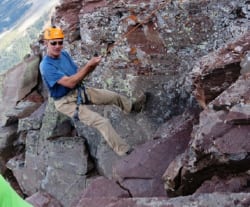
Difficulty: Class 4
Exposure: severe in places
Summit: 14,014 feet
Elevation Gain: 4,500 feet
Roundtrip: 10 miles
Trailhead: Maroon Lake at 9,590 feet
Climbers: Rick Crandall; Andy Mishmash, Rick Schultz & Dean Dombrowski Sep 25, 2014
The Maroon Bells are 14ers that are Colorado’s most recognized mountains. They are often cited as the most photographed mountains in North America. These peaks are stunning to look at. It’s that simple. Nothing beats their paired-pyramid symmetry framed inside the gorgeous Maroon Lake u-shaped valley. It’s why over 250,000 people visit these peaks in the 4 ½ month season.
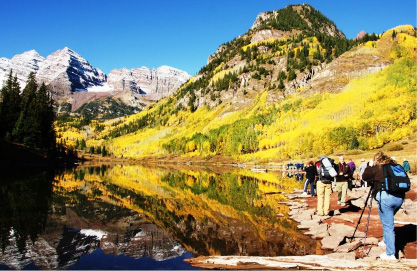
Hundreds of photographers arrive at the north side of Maroon Lake each Fall to capture the exact moment when the Aspen trees are at peak yellow, the sun rises to eliminate the shadowing on the pine trees on the left, the lake is an undisturbed mirror of the peaks, and the first snow up high has filled the angled ledges on the Maroon Bells. That usually happens at about 9 or 9:30 am before the wind picks up and stirs the lake surface.
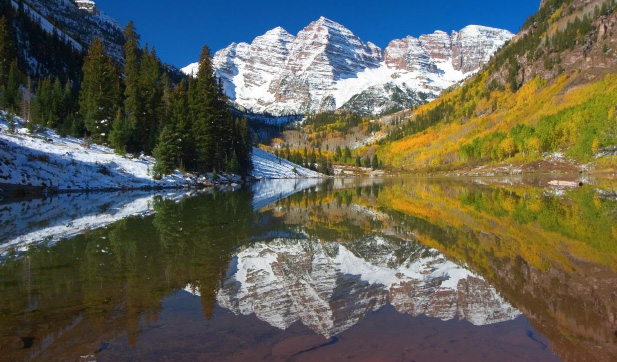
This is the “money shot” (taken a few years ago) when all conditions are met. The left (further) peak is South Maroon Peak and the sister peak to the right is North Maroon.
Aspen
The Maroon Bells are practically the logo of Aspen, an authentic Colorado town that dates back to the silver-mining boom. In the 1870’s a rush of prospectors surged into the Colorado high country establishing mining camps such as Leadville and Twin Lakes. At this time the Roaring Fork valley belonged legally to the Mountain Utes as part of their reservation. The tribe’s aggressive defense of its lands initially discouraged prospecting activity in the valley that now houses Aspen. On July 4th 1879, John Williams struck the Belden vein high in the headwaters of the Roaring Fork and the rush was on.
The town of Independence soon grew up around Williams’ claim, boasting forty businesses and its own stamp mill. Gold was found in the hills above Castle Creek in 1881, and Ashcroft became the second boomtown in the Aspen mining district. The Independence Pass Road was completed in 1882, and a daily stage ran from Aspen to the larger town of Leadville until 1887. Also in 1887 the Pearl Pass road was completed providing a route for hauling ore to the stamp mills and railheads of Crested Butte. In 1882 marble beds were discovered beside the Crystal River and soon the town of Marble was established.
Eventually after hostilities with the Mountain Ute, the tribe was exiled to an impoverished reservation in the Four Corners area and full-scale development in the Aspen area commenced.
The town of Aspen was booming by 1885, and the mines of Aspen produced $40 million in silver in a six year period from 1887. The signing of the Sherman Silver Act in 1890 established a silver standard for the U.S. dollar. Accordingly silver prices first shot up and then went bust three years later when the silver standard was abandoned. Independence and Ashcroft quickly became ghost towns. The last of the big mines fell silent in 1930.
Maroon Bells
Almost any visitor to Aspen will make the drive to Maroon Lake to see “the Bells.” The Maroon formation is made up of iron-stained siltstone forming the brilliant blood-red colors of the Bells and Pyramid Peak. Skilled climbers will describe North Maroon Peak, the most visible from the Lake, as one of their favorites of all the 14ers. It is likely that’s because the views on the way up and at summit are among the most impressive of all the 14ers.
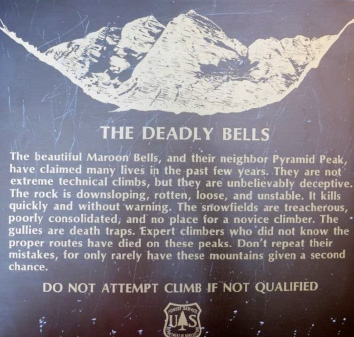
The reputation of casualties on the Bells comes largely from North Maroon Peak. After 2 deaths in 2012, Aspen Mountain Rescue climbed the peak to see if anything new was causing the deadly falls which usually occur at the upper reaches where there are vertical chimneys, cliff bands and loose rock.
Warning sign at Maroon Lake
Here’s what the Summit Post says: “North Maroon’s Northeast Ridge Route is the proud owner of one of the most difficult crux moves of any standard 14er route. It’s the crux that makes this route class 4.”
“the crux of North Maroon is nothing but loose and exposed. Pulling on the wrong rock can and does prove to be fatal”
Exposure is present for hours of the climb on this mountain, so if that makes you nervous, skip this mountain. The old adage,“don’t look down” in my view is not good advice. If you can’t be OK with steep drop-offs all around you, whether you’re looking down or not, I would suggest avoiding the 14ers that have significant exposure.
I’d been concerned about whether I had the ability to climb this mountain, and there was only one climber I’d attempt it with. Andy Mishmash is a good friend, a highly accomplished technical mountain and ice climber and loves these mountains to the extent that helping a much less competent but equally enthusiastic climber like me is a joy to him. I score highly on the enthusiasm meter and fortunately Andy is never in a rush to just tag a summit. It also helps that he has been up North Maroon in excess of 25 times over the years – no exaggeration.
Still, when I’m concerned I like to do research. So I spoke with Aspen Mountain Rescue who sent me one helpful and the other not so helpful images they’d taken from their helicopter.
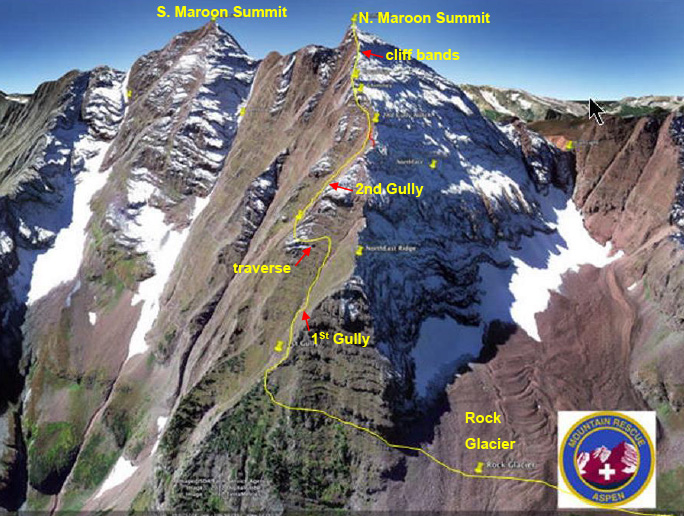
View of North Maroon from Aspen Mountain Rescue helicopter. The climbing route is in yellow – after hiking up well past Crater Lake from Maroon Lake, then first crossing a rock glacier (snow underneath) then up the 600’ steep “1st gully,” crossing over a ridge and up an even steeper and looser 2nd gully to a ridge from which there are hours of exposed rock climbing to summit.
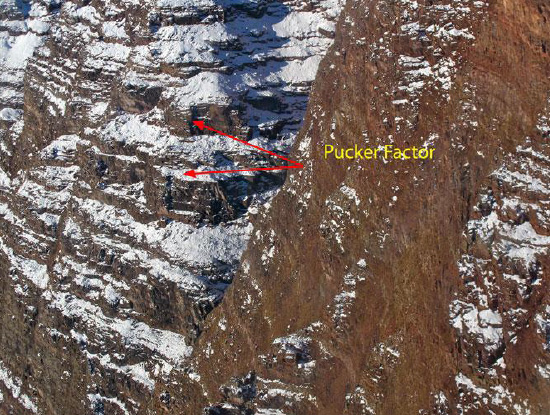
This second image from Aspen Mountain Rescue calls out two place of “pucker factor” but I can tell you there are a few others further up.
Well the weather was forecasting totally clear – important because it was going to be a long day. We were joined by friend Rick Schultz (the Autograph Source in Aspen) who had done South Maroon with us two years ago, and is a fit and avid cyclist, among other sports. Also joining us was Dean Dumbrowski, owner of Double D Property Management and who is a Class 5 climber. Both were OK with going for North Maroon at my slower speed.
The Climb
The days are shorter in September and we wanted to get back to our cars in daylight for once this summer. So we all met at the Maroon Bells parking lot and started our adventure at about 4:25 am.
We hiked in the dark for 2 ½ hours, up to and past Crater Lake and almost to the “rock glacier” by the time dawn came.
I always like a start in the dark because somehow hiking in the dark is a freebie – it doesn’t seem to have the physical impact compared with hiking in daylight.
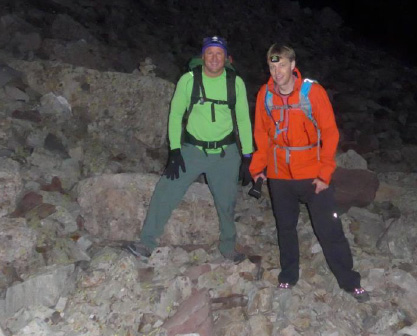
Dean (left) and Rick Schultz (I’ll call Rick S. here) on the rocky approach to the very rocky “rock glacier.”
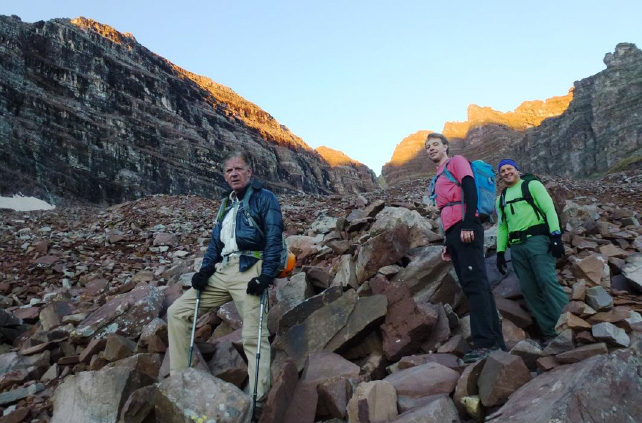
After about 3 miles and 1600’ of elevation gain, we got to the rock glacier just as sun began lighting up the upper reaches. A rock glacier is a huge field of rocks that fall year after year from the upper reaches of the mountains. The rocks sit atop compacted snow which causes the rocks to move from season to season. The massive North face of N. Maroon and it’s ledges began to show at upper left in the background.
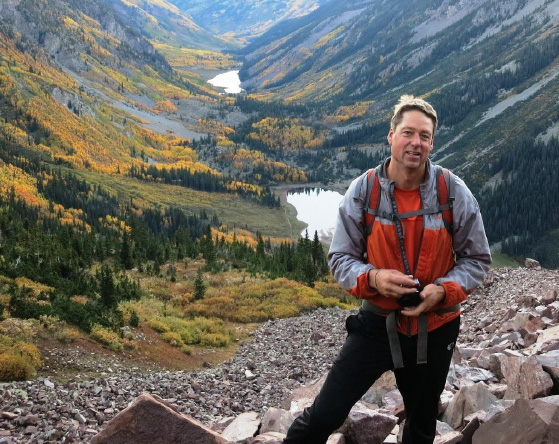
Andy relaxes after crossing the rock glacier. As the sun rose, the flaming Fall colors of Aspen trees turning yellow created the ultimate Fall scene. Maroon Lake (our start for the day) is in the distance and Crater Lake is just behind and below Andy.
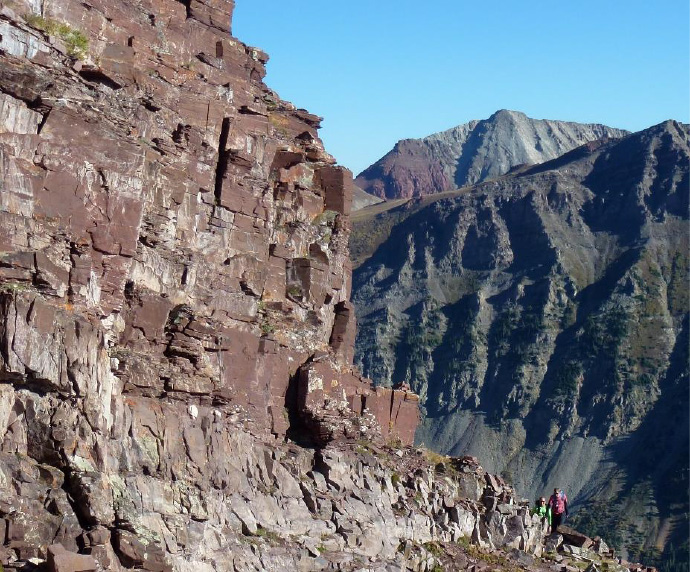
Dean and Rick S. rounding the “corner” of N. Maroon’s Northeast ridge.
The next step is to circle left around the mountain to its Northeast side. Going around a corner at 11,950’ exposes a long and steepening gully, one of two we needed to climb that would lead to N. Maroon’s Northeast ridge.
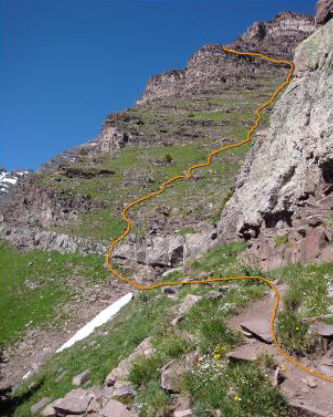
The route is to zig-zag 600’ up this 1st gully until a trail segment leads left over a ridge.
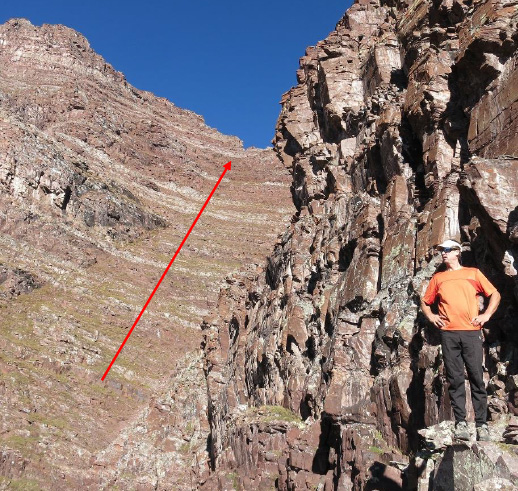
On the other side of the traverse from the 1st gully, the 2nd gully makes its appearance. This gully is even steeper and toward the upper reaches you get into climbing up some of North Maroon’s highly visible ledges.
Here Andy is perched taking in the views.
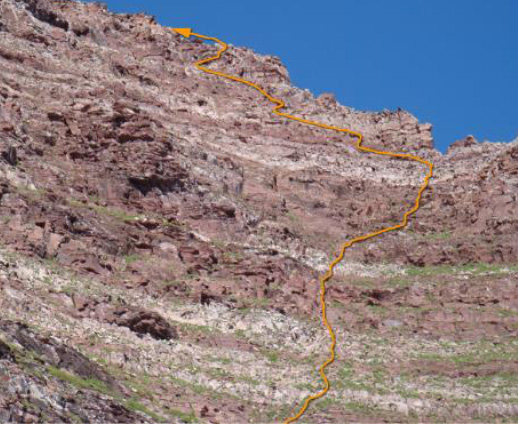
This is near the top of the 2nd gully. The route aims for the notch in the ridge on the upper right and then veers left into Class 3 climbing over ledges and cliff bands towards the ridge crest at 13,200’.
The exposure starts here and doesn’t quit until summit, still hours away.
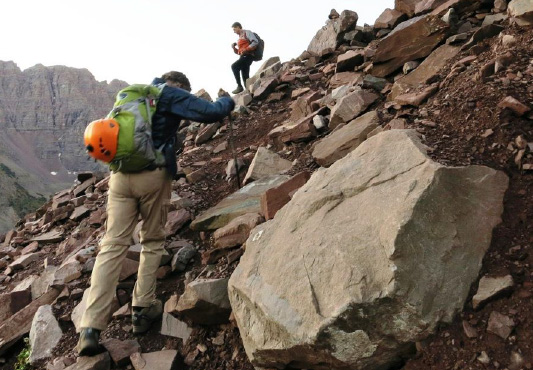
Andy is above and Rick C. is below working up the increasingly steep and loose 2nd gully.
Soon I would stash the poles as they become a hindrance with Class 3 climbing.
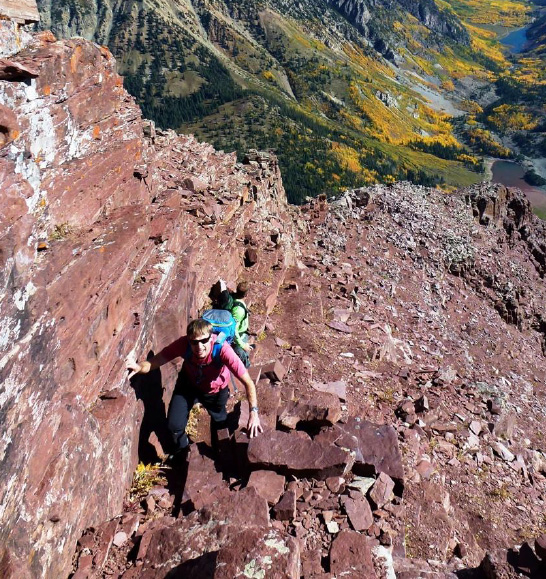
Rick S. entering the ledges and cliff bands leading to the NW ridge crest.
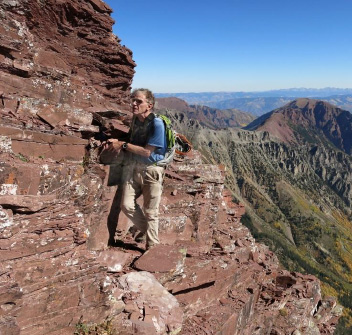
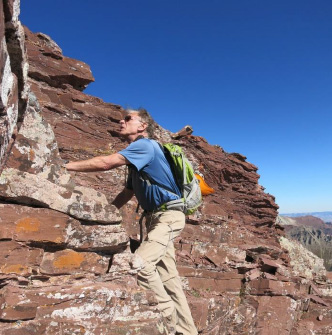
A photo collage of Rick C. climbing the famous and highly visible Maroon ledges.
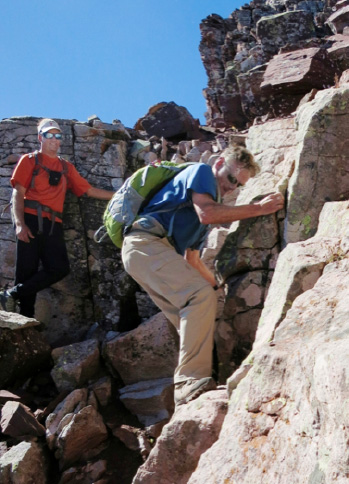
Andy watches me – I’m sure he was checking out if I’ve learned anything about hand and footholds as we head up the ledges and cliff bands. He’s got a smile so I must be doing good.
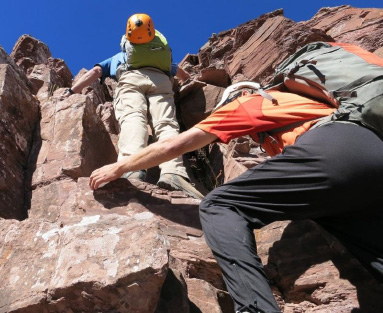
But every now and then in places where exposure gets more severe – he’s right behind me – that’s what you call a security blanket!
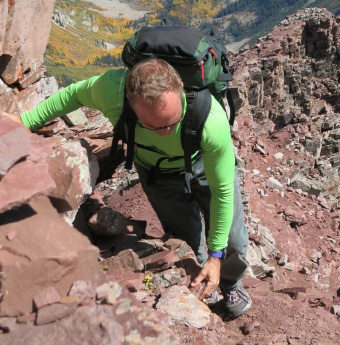
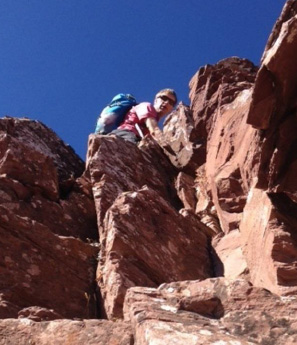
Dean (above left) and Rick S. (above right) scampered up these rocks with no problem. However, not to be out-done, some mountain goats decided to climb up with us to show us how it’s really done.
We’ve seen the goats before, see the Pyramid story at https://www.rickcrandall.net/pyramid-peak-a-dream-climb-2/ where I describe how the goats are outfitted physically to be such good climbers.
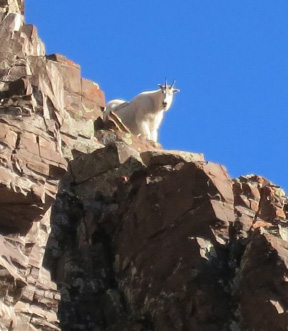
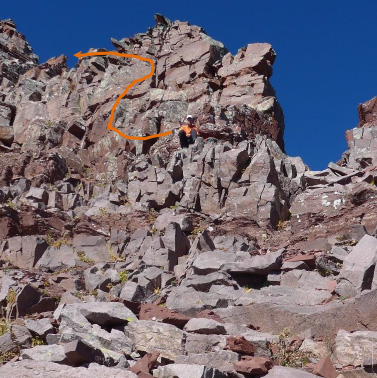
Andy waiting patiently just to the left of the notch as we reached the ridge crest.
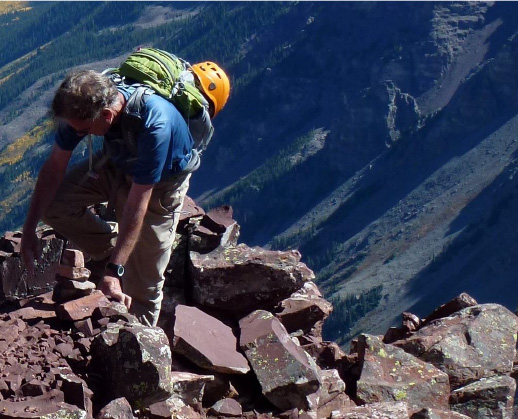
Once on the ridge at 13,200’ there’s lots more Class 3 climbing.
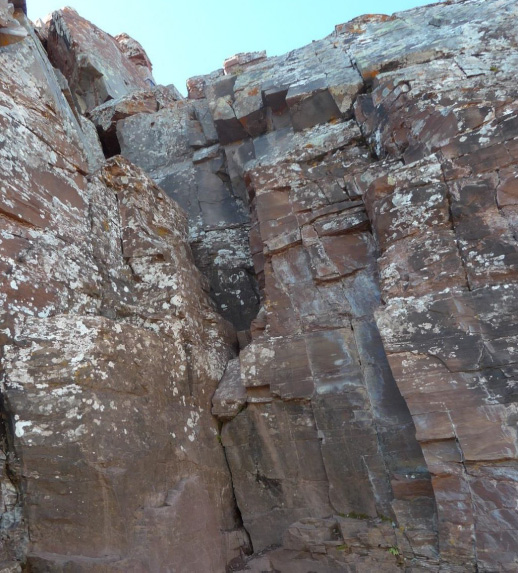
After another 400’ of vertical, we finally arrive at the cliff band that is the crux of the climb. A portion of it is shown here. This is Class 4 exposed climbing but we found a way up it.
As you’ve heard many times, it’s not so much about how you get up a wall like this, but rather how to get back down it. I had real reservations about that, but I figured Andy would find us a route. For now, we stayed focused on the remaining 425’ to summit.
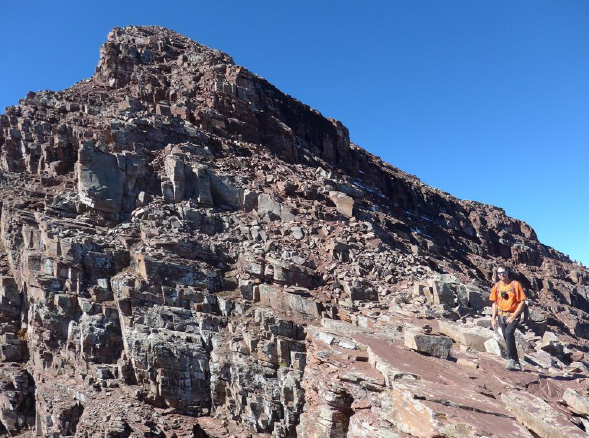
Above the cliff band the remaining route to summit is very loose but mostly not as steep as what we’d just done. Somewhere half-way up this, for the first time I actually got the feeling summiting was possible!
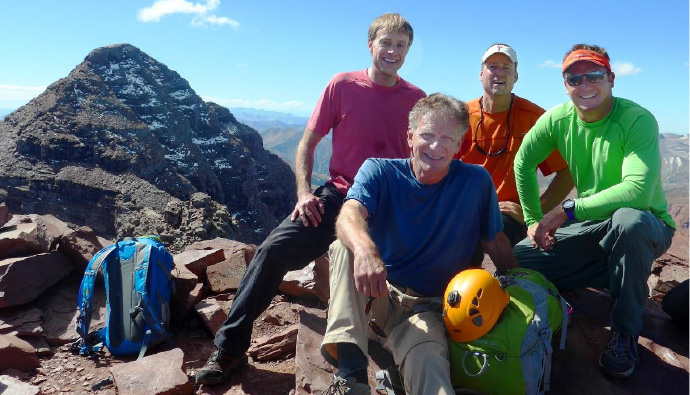
Summit N. Maroon Peak, 14,014’ at 11:50 am, 7 hrs. 35 minutes from trailhead. That is S. Maroon behind us that we’d summited 2 years ago. This was a more difficult and sweeter victory. However, down-climbing is where all the casualties happen and we still had that ahead of us.
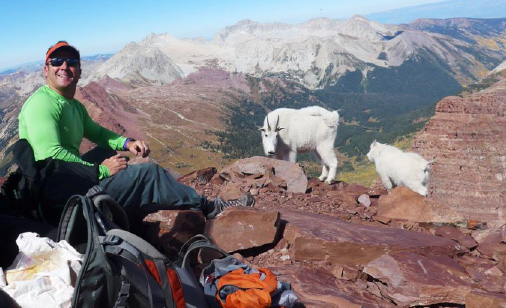
Would you believe our goat friends summited with us?? And one of them is a baby. They are amazing climbers – they make it look effortless.
Dean wanted this shot for his kids.
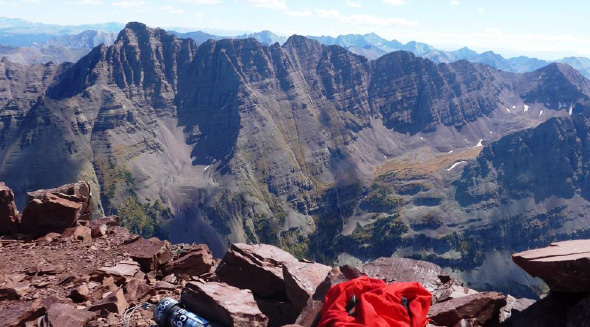
The summit canister is in the foreground (with pencil and paper inside providing evidence of summiting), and Pyramid Peak is in the background on the left.
Since it was just about noon, we had a leisurely lunch on the summit with only one other pair of guys reaching the summit all day, and they had traversed from S. Maroon. They were from a new web magazine called TrailGroove.com and were collecting climbing and hiking stories for their magazine. It turns out they were the climbing partner of the guy who fell off K2 on the way back from Capitol on Sep 14th exactly where I was the week before (see Capitol/K2 story athttps://www.rickcrandall.net/capitol-peak-and-k2-most-challenging-of-all-colorado-fourteeners/ ). He told us: “I was the climber’s climbing partner as well as the first responder that stabilized the climber and got him out. It was his third time on Capitol, and i have personally climbed the Wilson to El Diente traverse with him along with other hard climbs, so he is a capable climber. It was just a bad luck and a bad situation.”
Hearing that story while on the summit of an even more difficult mountain perked us up but we really didn’t need any more motivation to take care on our way down.
The day was a page out of a storybook. The sun was out, there was no wind at summit and no weather in the distance to worry about. The Fall colors and views were more like paintings than photos. It was glorious. Unbelievably we were the only ones climbing the N. Maroon route the whole day. What a privilege!
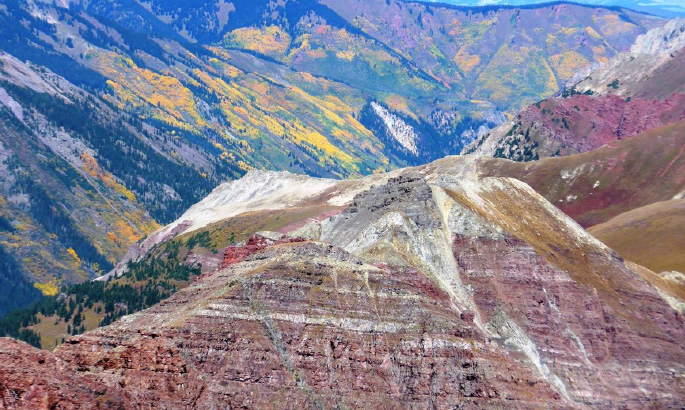
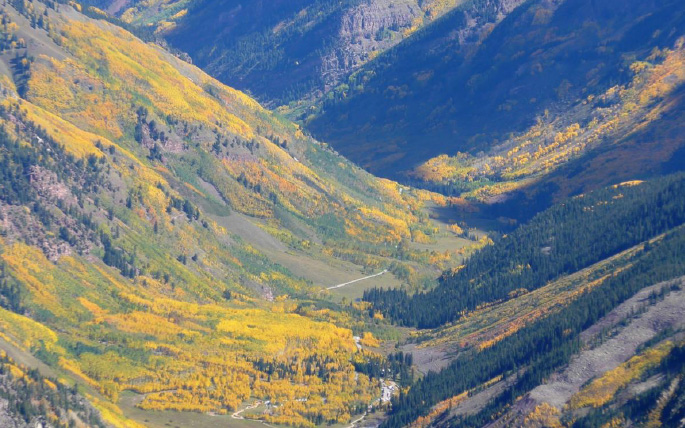
Well at about 12:30 pm we reluctantly put on our packs and started down that loose summit cap towards the ridge crest where that cliff band awaited us. There were some careful moves needed almost right away, but with no pressure on speed, we (translate to mean “I”) had all the time I needed to find good handholds, push my body out from the mountain so that feet pressured into the mountain and so that I could spot where to lower to next.
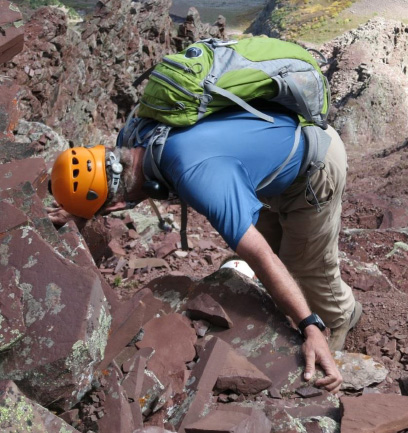
Of course in the second photo you can see Andy lurking below watching my moves like a teacher quietly grading my performance – and occasionally calling out a hidden toe-hold for which I was grateful.
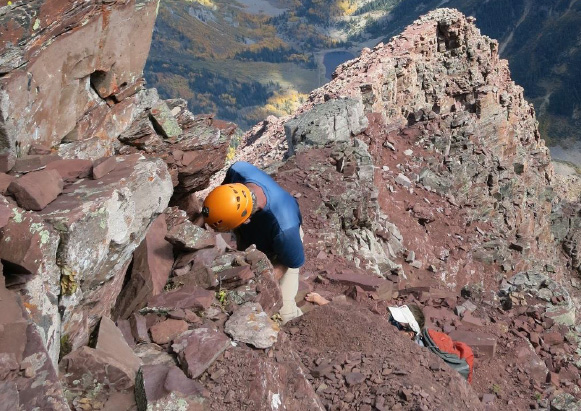
We got down to the top of the crux cliff band and while Rick S. and Dean were studying how one might attempt to down-climb it (with lots of hesitation) Andy was quietly emptying his pack and scouting a belay point above on some solid rock.
He gave me a harness to put on, put one on himself, and then climbed up to rig a rope for rappelling down the cliff.
I was quite excited about the prospect – a great addition to this story and it recalled me back to when my son Brett was 13 or 14 and we travelled to Israel for some Jewish adventuring. We hired an Israeli-army climbing expert who took us to some cliffs near the Dead Sea where we rappelled down past the cave where the Dead Sea Scrolls were found! That was 18 years ago.
Anyway back to the present – rappelling is where you walk backwards over a cliff leaning way out so your feet are perpendicular to the vertical wall and you walk down like Spiderman. Of course you need a lot of trust that the guy on the other end of the rope is lowering you at the right pace and won’t let go.
There’s another way to rappel where you lower yourself down, but Andy judged this way was safest.
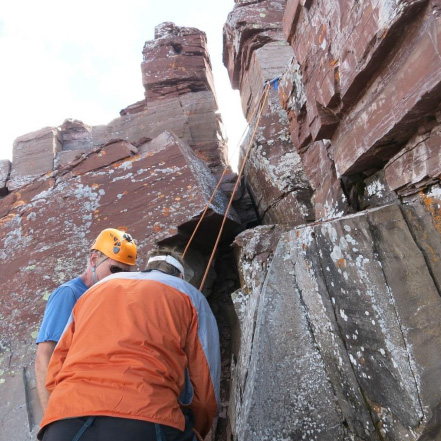
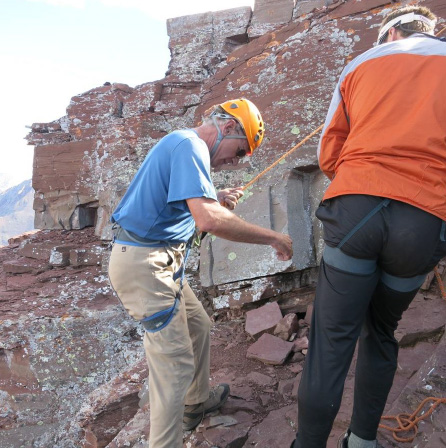
OK then, just behind me is the drop-off.
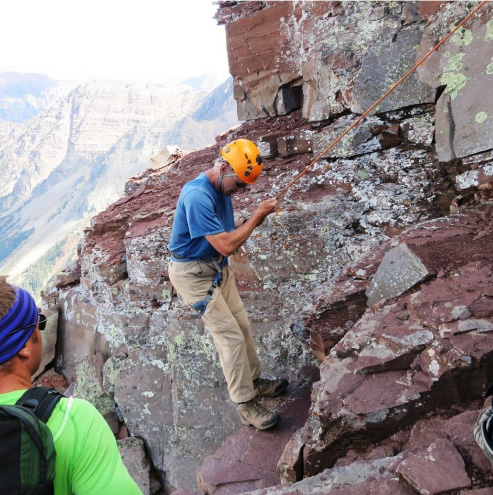
Over we go.
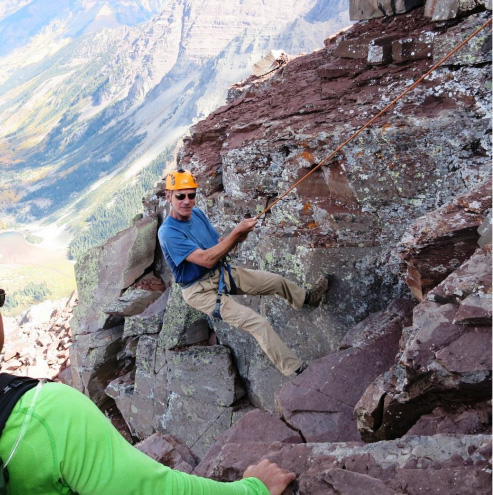
Rick S. kept looking over the wall debating whether to try free-climbing it down, but in the end he and Dean made wise decisions to take advantage of the rig Andy had set up. Why take the risk when this is where the casualties happen on this notorious mountain and we had a fun way to get down?
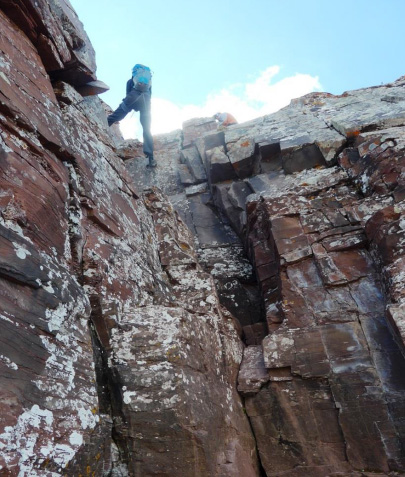
Rick S. starting his rappel down the wall.
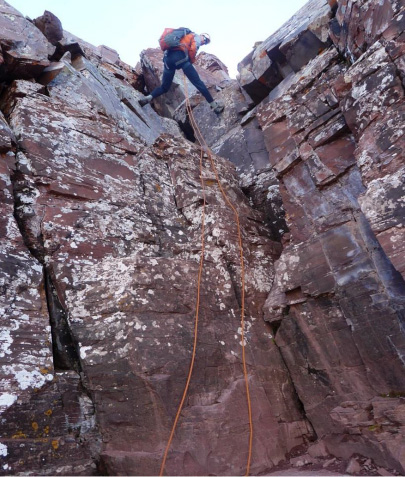
Once we were all down, Andy casually walked down his ropes and that was that!
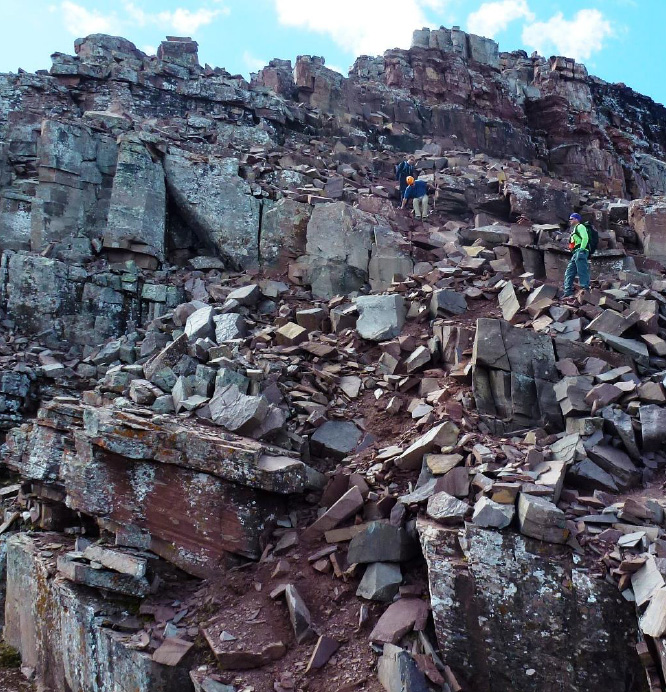
We still had hours of rock down-climbing to go but with careful selection to find solid rock (it doesn’t look like anything is solid in this picture),
We had lots of energy munchies in our packs and no pressure from the weather, we cruised down having a great time with my friends having to cope with my unbridled enthusiasm that we were about to declare victory on North Maroon – one of the more challenging of all the 14ers.
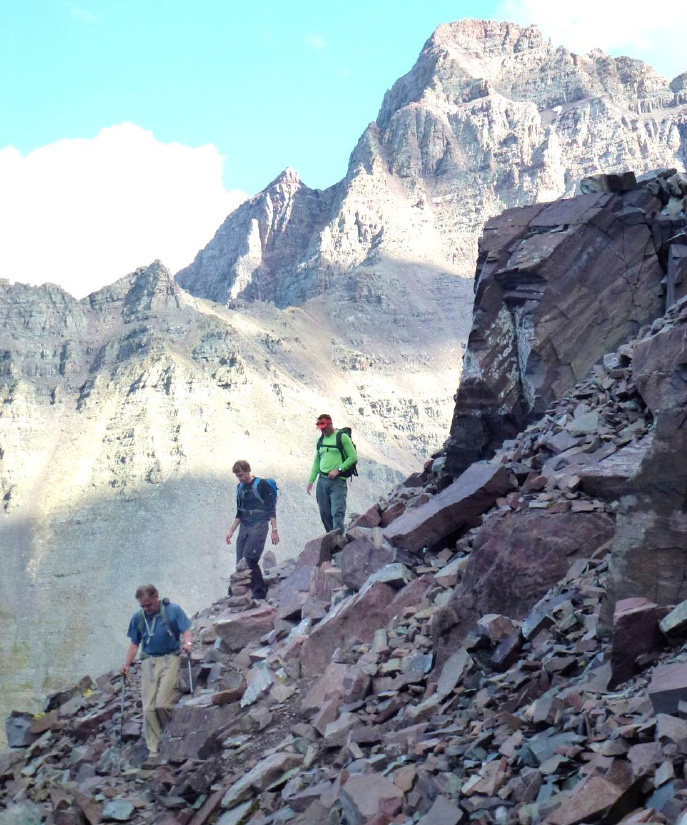
As we descended and looked around, it was hard to believe such raw beauty was all around us and we were just 12 miles from a cappuccino at Peaches in Aspen!
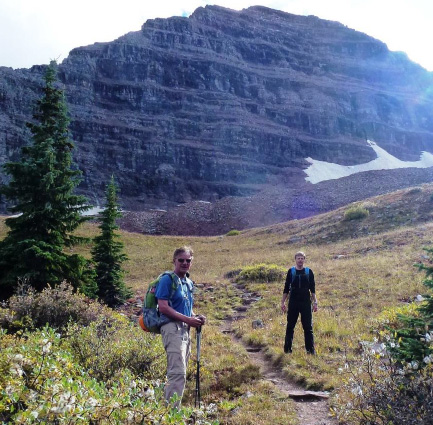
On our walk-out we looked back at that awesome North face of the mountain we’d just summited.
The day was already more like a dream than a reality – which is why I write these stories to “pinch” myself into remembering the special gift it is to be able to experience this beauty.
As we got back to Maroon Lake at about 7 pm (yes, another 14 ½ hour day climbing!) the light was magical and the Lake was nearly calm – here’s a parting shot of the Bells – the peak that looks bigger in front is North Maroon.
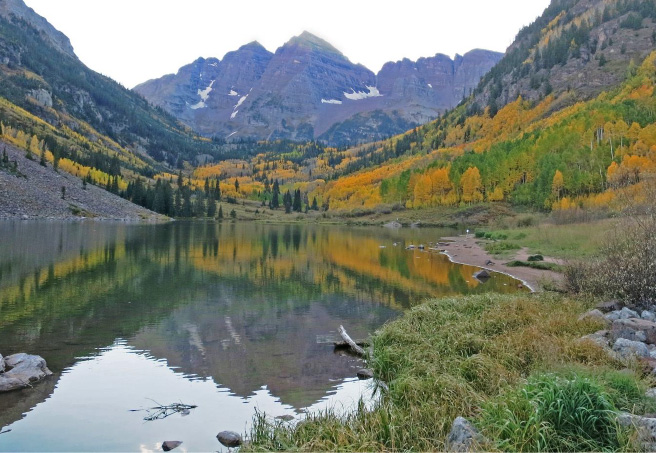
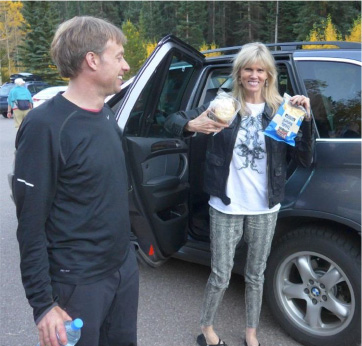
Rick’s wife Tricia had been watching our Spot Tracking on and off all day and timed her arrival at the Bells parking lot with cookies, sandwiches, water and a big congratulatory hug.
Now that was a great finish to an indescribably great day.
Huge thanks to Andy for all of his care, route-finding, coaching and safety preparation. Also thanks to Rick S. and Dean for joining to make this such a great day.
There was all joy and no stress on this normally very challenging mountain.


